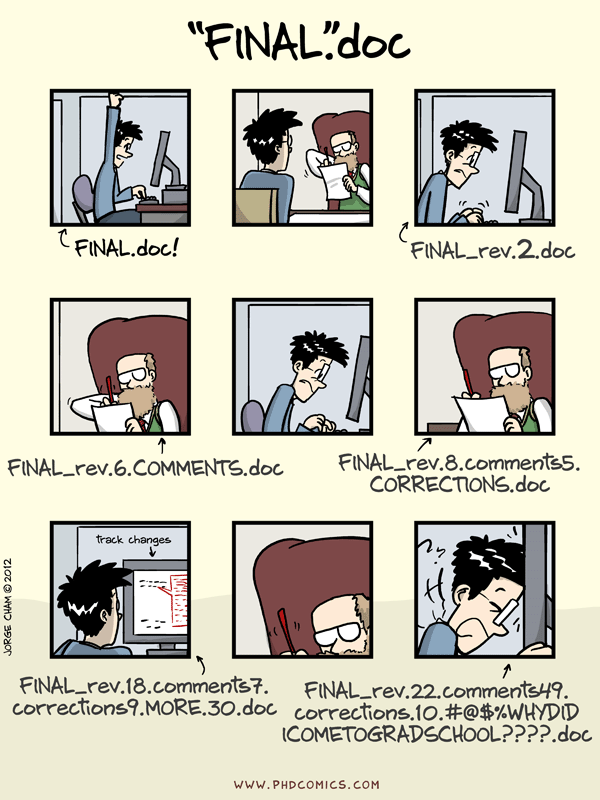Introduction to git
Contents
Introduction to git#
BB1000 Programming in Python KTH
layout: false
Learning objectives#
What version control is
Why we should use version control
Why we choose use git
Know about the basic components in git
work directory
staging area
repository (local, remote)
branches
Know commands for basic git workflow
How to save history
How to undo mistakes
How to collaborate with others (github)
What is version control:#
A Version Control System (VCS) is a frameorks that tracks the history of a project
The history of a project is a sequence of versions
At any point in time we can go back to a previous version
A VCS allows you to compare different versions
A VCS allows several users to work on the same project files simultaneously
Why use version control#
You may already have used some manual version…
$ cp -r Project Project.save
… some work …
$ cp -r Project Project.save.v2
… some work …
$ cp -r Project Project.save.v2.new

Introducing git#

Written by Linus Thorvalds, originally for the Linux kernel
A distributed Version Control System
Several servers have all information
Any one can be chosen as the reference version
One of the most popular frameworks today (others: bazaar, mercurial)
Historical frameworks (subversion, CVS, RCS)
When to use#
Scenario#
For source code development
For manuscripts
In single-user projects
In collaborative projects
Benefits#
No history is lost
All versions of your documents are preserved
Easy to backup to other sites
Concepts#
Work directory: local directory where you work
Cache: temporary area for files you intend to keep
Commit: a snapshot of the project files at a point in time
Repository: sequence/tree of commits (history of the project)
Concepts#
Work directory: local directory where you work
Cache: temporary area for files you intend to keep
Commit: a snapshot of the project files at a point in time
Repository: sequence/tree of commits (history of the project)
11 basic commands#
- Initialize
- clone
- init
- Queries
- status
- log
- diff
- Changing locally
- add
- commit
- merge
- Remote interaction
- push
- fetch
- pull
Setup#
The first time around#
$ git config --global user.name "First Last"
$ git config --global user.email "first.last@isp.com"
Creates a configuration file ~/.gitconfig
[user]
name = First Last
email = first.last@isp.com
Note: You can create and edit the file directly
Initializing a repository#
Use an existing directory or create a new project directory
$ mkdir proj
proj/
Go to the directory and initialize
$ cd proj
$ git init
Initialized empty Git repository in (...)proj/.git/
proj/
└── .git
proj/ └── .git
Check status#
Check repository status
$ git status
On branch master
No commits yet
nothing to commit (create/copy files and use "git add" to track)
proj ├── .git └── hello.py
Create a new file hello.py#
#hello.py
print("Hello world!")
Recheck status
$ git status
On branch master
No commits yet
Untracked files:
(use "git add <file>..." to include in what will be committed)
hello.py
nothing added to commit but untracked files present (use "git add" to track)
Git warns about untracked files
proj ├── .git └── hello.py
Add file to Git#
$ git add hello.py
$ git status
On branch master
No commits yet
Changes to be committed:
(use "git rm --cached <file>..." to unstage)
new file: hello.py
The staging area/cache#
After
git adda file is in the staging area (cache)This is an intermediate level between the work directory and repository
proj ├── .git └── hello.py
Save to repository#
Save the latest changes in the local repository (in
.gitdirectory)
$ git commit -m "First hello"
[master (root-commit) cf06b48] First hello
1 file changed, 1 insertion(+)
create mode 100644 hello.py
Check the status again
$ git status
On branch master
nothing to commit, working directory clean
The work cycle#
There are three levels
The work directory
The staging area
The repository
repository (.git)
^
| commit
staging area (cache)
^
| add
work directory <- init
The work cycle#
There are three levels
The work directory
The staging area
The repository
repository (.git)
^
| commit
staging area (cache)
^
| add
work directory <- init
The basic work cycle is edit-add-commit
$ <edit> <file> # edit your file
$ git add <file> # cache your changes
$ git commit -m <message> <file> # save your changes in repository
Review history#
To see the commit history of the project files
$ git log
commit cf06b48ceb6f9c301867373845bd59e6620fb72f (HEAD -> master)
Author: First Last <first.last@isp.com>
Date: Tue Mar 19 13:25:10 2019 +0100
First hello
Viewing changes#
Consider a modified file
$ cat << EOF > hello.py
print("Hello there world!")
EOF
git now recognizes this tracked file as modified
$ git status
On branch master
Changes not staged for commit:
(use "git add <file>..." to update what will be committed)
(use "git checkout -- <file>..." to discard changes in working directory)
modified: hello.py
no changes added to commit (use "git add" and/or "git commit -a")
Viewing changes (continued)#
git diffshows the changes
$ git diff
diff --git a/hello.py b/hello.py
index f1a1813..086befc 100644
--- a/hello.py
+++ b/hello.py
@@ -1 +1 @@
-print("Hello world!")
+print("Hello there world!")
Update repository#
$ git add hello.py
$ git commit -m "Change greeting"
[master 04064bc] Change greeting
1 file changed, 1 insertion(+), 1 deletion(-)
$ git log
commit 04064bc84ecaee64e3fb4c3dd54b73da33ec6986 (HEAD -> master)
Author: First Last <first.last@isp.com>
Date: Tue Mar 19 13:33:10 2019 +0100
Change greeting
commit cf06b48ceb6f9c301867373845bd59e6620fb72f
Author: First Last <first.last@isp.com>
Date: Tue Mar 19 13:25:10 2019 +0100
First hello
Recovering old work#
To retreive old verions, use checkout with the commit string
$ git checkout cf06b4
Note: checking out 'cf06b4'.
You are in 'detached HEAD' state. You can look around, make experimental
changes and commit them, and you can discard any commits you make in this
state without impacting any branches by performing another checkout.
If you want to create a new branch to retain commits you create, you may
do so (now or later) by using -b with the checkout command again. Example:
git checkout -b <new-branch-name>
HEAD is now at cf06b48 First hello
$ cat hello.py
print("Hello world!")
Switch back to latest version#
$ git status
HEAD detached at cf06b48
nothing to commit, working tree clean
$ git checkout master
Previous HEAD position was cf06b48 First hello
Switched to branch 'master'
$ git status
On branch master
nothing to commit, working directory clean
$ cat hello.py
print("Hello there world!")
Remote repositories#
Necessary for collaborative projects
Useful for single-user projects
Web-services, github, bitbucket
A shared directory (NFS, AFS, Dropbox….)
git pull from remote
git push to remote
repository (.git) <-> remote
pull,push
^
| commit
staging area (cache)
^
| add
work directory <- init, clone
Backup to remote#
View local changes
$ git status
On branch master
Your branch is ahead of 'origin/master' by 1 commit.
(use "git push" to publish your local commits)
nothing to commit, working directory clean
Backup to remote repository
$ git push
Counting objects: 5, done.
Writing objects: 100% (3/3), 269 bytes | 0 bytes/s, done.
Total 3 (delta 0), reused 0 (delta 0)
To /home/olav/Dropbox/proj.git
f7efe62..cb05b3f master -> master
Continue work on another computer#
With access to the same shared file system
|Other> git clone ~/Dropbox/proj.git
Cloning into 'proj'...
done.
|Other> cd proj
work on remote
edit -> add -> commit -> push
Back on local#
Retrieve changes that was made on another system
By you or another developer
$ git pull
remote: Counting objects: 5, done.
remote: Total 3 (delta 0), reused 0 (delta 0)
Unpacking objects: 100% (3/3), done.
From /home/olav/Dropbox/proj
cb05b3f..d5fe073 master -> origin/master
Updating cb05b3f..d5fe073
Fast-forward
hello.py | 2 +-
1 file changed, 1 insertion(+), 1 deletion(-)
Summary of work cycle#
Start a new project
$ git init
Get a copy of existing project
$ git clone
Locally: edit-add-commit
$ vim ...
$ git add...
$ git commit...
Sync with remote: pull-push
$ git pull
$ git push
Use a remote server (service)#
github.com (free for public projects)
gitlab.com (free for public and private projects)
Links#
http://git-scm.com/book
http://swcarpentry.github.io/git-novice/
http://www.linux.com/news/featured-blogs/185-jennifer-cloer/821541-10-years-of-git-an-interview-with-git-creator-linus-torvalds
https://gun.io/blog/how-to-github-fork-branch-and-pull-request/
https://www.linux.com/learn/fixing-mistakes-git
http://christoph.ruegg.name/blog/git-howto-revert-a-commit-already-pushed-to-a-remote-reposit.html
http://git-man-page-generator.lokaltog.net/
